The AMD Ryzen 3 1300X and Ryzen 3 1200 CPU Review: Zen on a Budget
by Ian Cutress on July 27, 2017 9:30 AM EST- Posted in
- CPUs
- AMD
- Zen
- Ryzen
- Ryzen 3
- Ryzen 3 1300X
- Ryzen 3 1200
Benchmarking Performance: CPU Rendering Tests
Rendering tests are a long-time favorite of reviewers and benchmarkers, as the code used by rendering packages is usually highly optimized to squeeze every little bit of performance out. Sometimes rendering programs end up being heavily memory dependent as well - when you have that many threads flying about with a ton of data, having low latency memory can be key to everything. Here we take a few of the usual rendering packages under Windows 10, as well as a few new interesting benchmarks.
All of our benchmark results can also be found in our benchmark engine, Bench.
Corona 1.3: link
Corona is a standalone package designed to assist software like 3ds Max and Maya with photorealism via ray tracing. It's simple - shoot rays, get pixels. OK, it's more complicated than that, but the benchmark renders a fixed scene six times and offers results in terms of time and rays per second. The official benchmark tables list user submitted results in terms of time, however I feel rays per second is a better metric (in general, scores where higher is better seem to be easier to explain anyway). Corona likes to pile on the threads, so the results end up being very staggered based on thread count.
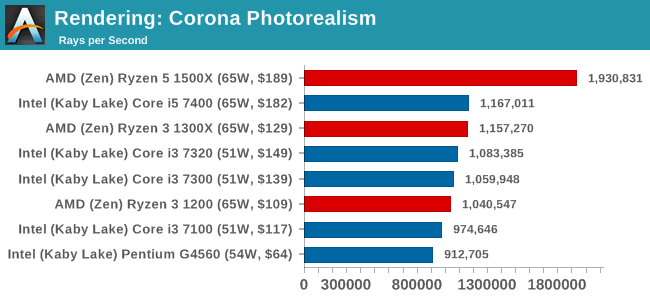
Blender 2.78: link
For a render that has been around for what seems like ages, Blender is still a highly popular tool. We managed to wrap up a standard workload into the February 5 nightly build of Blender and measure the time it takes to render the first frame of the scene. Being one of the bigger open source tools out there, it means both AMD and Intel work actively to help improve the codebase, for better or for worse on their own/each other's microarchitecture.
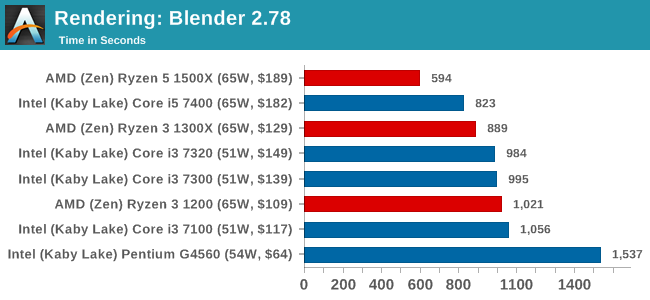
LuxMark v3.1: Link
As a synthetic, LuxMark might come across as somewhat arbitrary as a renderer, given that it's mainly used to test GPUs, but it does offer both an OpenCL and a standard C++ mode. In this instance, aside from seeing the comparison in each coding mode for cores and IPC, we also get to see the difference in performance moving from a C++ based code-stack to an OpenCL one with a CPU as the main host.
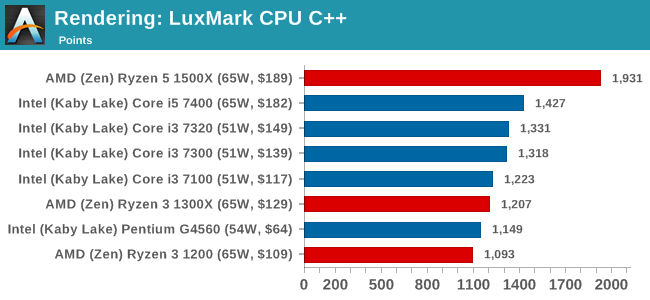

POV-Ray 3.7.1b4: link
Another regular benchmark in most suites, POV-Ray is another ray-tracer but has been around for many years. It just so happens that during the run up to AMD's Ryzen launch, the code base started to get active again with developers making changes to the code and pushing out updates. Our version and benchmarking started just before that was happening, but given time we will see where the POV-Ray code ends up and adjust in due course.
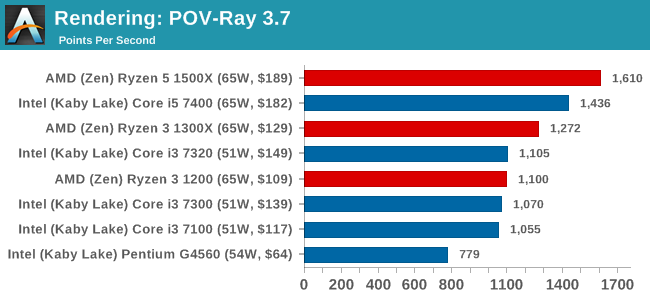
Cinebench R15: link
The latest version of CineBench has also become one of those 'used everywhere' benchmarks, particularly as an indicator of single thread performance. High IPC and high frequency gives performance in ST, whereas having good scaling and many cores is where the MT test wins out.
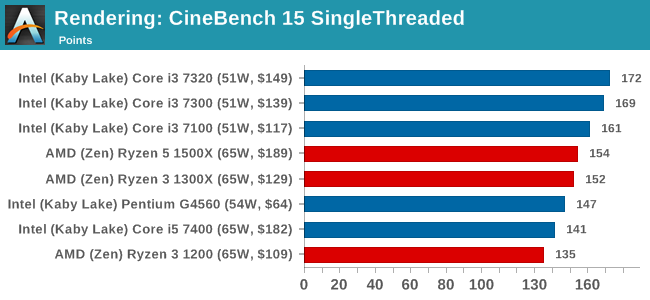
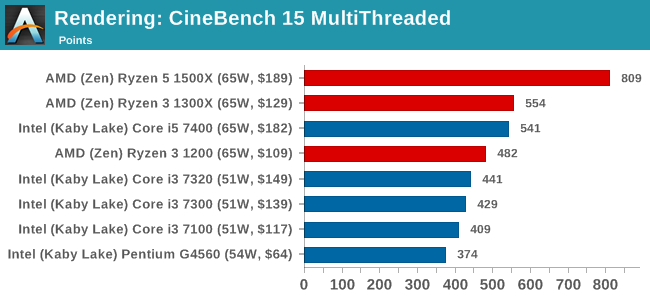










140 Comments
View All Comments
Ian Cutress - Thursday, July 27, 2017 - link
AMD doesn't use the R3 / R5 / R7 nomenclature - that's for graphics.Gothmoth - Thursday, July 27, 2017 - link
i don´t care about gaming or heating my house with a cpu..... so ryzen makes more sense for me. :)x299 was such a disappointment.
MrCommunistGen - Thursday, July 27, 2017 - link
Ian, first off, thanks for the benchmark numbers! I look forward to seeing the rest once they are completed.As far as data is concerned, is there a chance that the DigiCortex results have the wrong numbers next to a couple CPUs?
I'm specifically looking at the i3 7100 being the fastest Intel CPU at 0.63, compared to the rest of the offerings clustering together at 0.37-0.38. To me it looks like the 0.63 should be the i5 7400 and the 7100 should be with the other dual cores.
On another note, it looks like the RoTR Geothermal Valley scene really HATES AMD's HyperThreading - at least on Nvidia hardware/drivers. At first I thought there might be another set of numbers transposed somewhere since the Ryzen 3 CPUs perform SO MUCH better than the 1500X. But I looked back at the 1600X review and the numbers seem consistent -- bad performance on HyperThreaded AMD on a GTX 1080. Prophet's Tomb seems to behave better. Just shows how much architecture and software optimizations for said architecture can either oppose or compliment each other.
As for small typos, there's also a couple spots where the 1200 is referred to as "1200X". There was another one I found during my initial read that I can't find now that I'm commenting.
MrCommunistGen - Thursday, July 27, 2017 - link
Not the typo I was looking for, but I just noticed that the intro/description for Civ6 looks like it has a typo I've missed in previous articles:"...but every edition from the second to the sixth, including the fifth as voiced by the late Leonard Nimoy, it a game that is easy to pick up, but hard to master."
"it a game" should probably be "is a game"
Not a criticism, just trying to help out where I can. :)
MrCommunistGen - Thursday, July 27, 2017 - link
Gah... brain fart this morning. Please read my references to AMD "HyperThreading" as "SMT"... smhIan Cutress - Thursday, July 27, 2017 - link
i3 7100 should be 0.363x on DigiCortex. I've corrected three 7100 results today in our database from my personal master copy. I think I'll have to go through them all and double check.RoTR Geothermal on 1080p with a GTX 1080 really loves quad cores without hyperthreading, AMD or Intel. I'm not sure what it is with that test on that benchmark - in our KBL-X review, all the i5s got top results by a good margin. I think it's been optimized specifically for quad-core, or there's something iffy in the game code/drivers.
Appreciate the typo point outs for sure. These things are always last minute and you can never have too many eyes on it. :)
DanGer1 - Thursday, July 27, 2017 - link
The review is lacking, especially the value charts. Ryzens come with a cooler, their motherboards cost less and they are overclock-able. Adjusting the cost for the motherboard and the cooler changes the value charts significantly in R3's favor. Overclocking on stock air makes makes performance and value a no contest in favor of the R3s.MajGenRelativity - Thursday, July 27, 2017 - link
Intel's processors also come with a cooler.wallysb01 - Thursday, July 27, 2017 - link
Basic 1511 boards that would go into i3/Pentium builds are really not much more, if at all, than the lower end AM4 boards. Plus, the Intel stuff has an iGPU and if you're buying a low end desktop, you probably don't care a lot about heavily multithreaded workloads. So, I'd actually argue the i3/Pentiums are getting under sold in the value charts.Its kinda funny how the landscape has switched, in that Intel might actually be the better low-end, value winner, while AMD is the best mid/mid-high end value winner.
Gothmoth - Thursday, July 27, 2017 - link
+1 for overclocking.the tested intel cpus are sure not k models.
as for intel having internal GPU.. i never used them not even on my cheapest system builds.